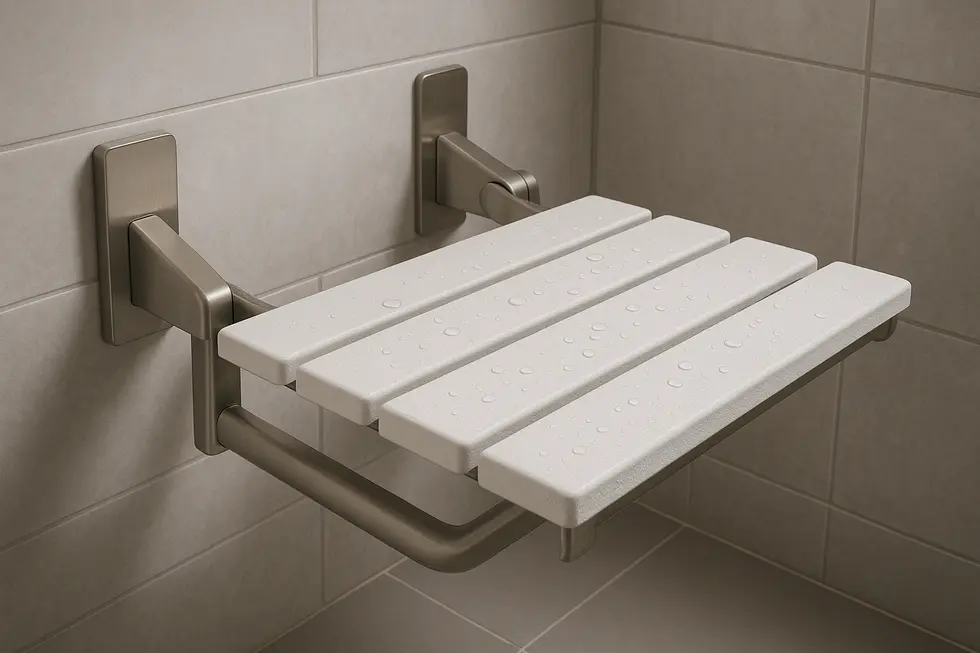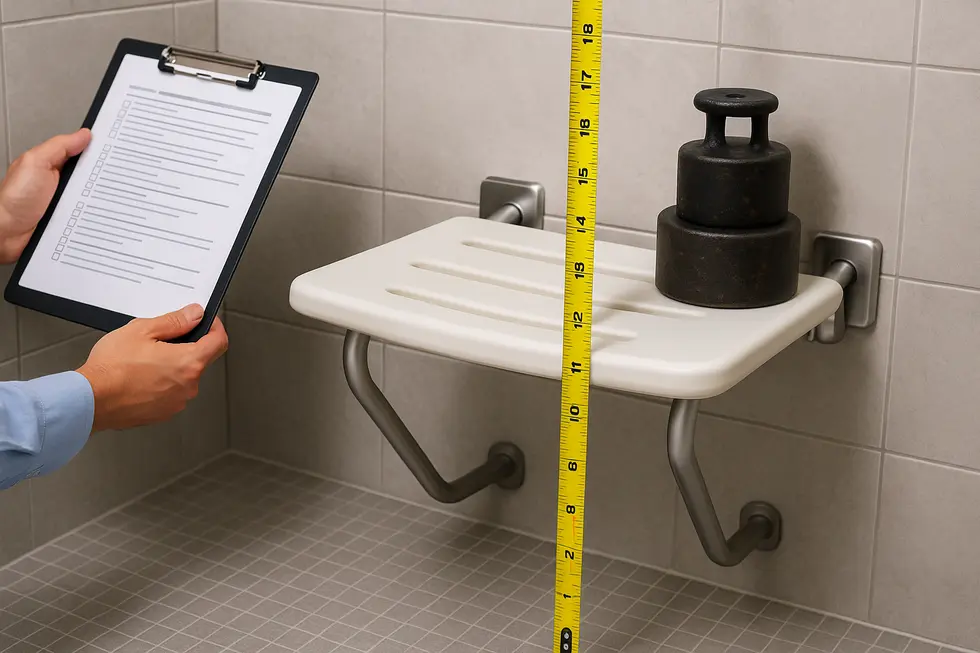Shower Seat
Secure Seating: The Rise of the Non-Slip Wall Mounted Shower Seat
A slip in the shower can turn a routine rinse into a serious accident. Non-slip wall mounted shower seats merge thoughtful engineering with inclusive design to reduce that risk while restoring confidence for users of any age or ability. The following chapters explore how breakthrough materials and smart ergonomics elevate performance, how current and projected market forces guide product availability, and how stringent safety regulations ensure every seat on the wall truly supports its occupant.
Beyond Steel and Silicone: Material Science Fuelling the Next Generation of Non-Slip Wall-Mounted Shower Seats

A wall-mounted shower seat is only as trustworthy as the materials and engineering hidden beneath its smooth surface. Recent breakthroughs start with the frame. Designers have traded traditional mild steel for marine-grade stainless or hard-anodized aluminium, alloys that shrug off humidity and salts for decades without pitting. These metals also deliver higher yield strength, allowing slimmer tube diameters that make the seat look airy rather than institutional.
The sitting deck itself has transformed even more dramatically. Early plastic slats could feel slick once soapy; now manufacturers mould glass-fiber-reinforced nylon or textured polypropylene laced with antimicrobial silver ions. The fibres add stiffness while trimming weight, so hinges carry less load during each fold. Micro-etched grip patterns—barely visible to the eye—create peaks and valleys that disperse water film, pushing wet-static-coefficient values beyond ADA minimums even when shampoo suds pool around the user.
Comfort no longer plays second fiddle to safety. Some premium inserts embed thin phase-change gel pads that store ambient warmth and release it as soon as skin contacts the surface, preventing that first cold shock. For multi-user bathrooms, modular rail tracks let installers fine-tune seat height after tiling is complete; locking cams secure the deck without another round of wall drilling.
Engineering refinements extend to the motion hardware. Fold-down torsion hinges now hide inside a 20-mm profile, relying on polymer bushings that resist mineral build-up. The mechanism supports gentle, near-silent deployment with less than five pounds of effort, important for arthritic hands. Strategically placed drainage slots evacuate water within seconds, reducing biofilm growth and drying time between showers.
Home renovators weighing these innovations against traditional benches can explore practical mounting advice and stud-finding strategies in a concise guide on step-by-step installation tips (https://pegabidet.com/2025/06/09/install-wall-mounted-shower-seat/).
For readers interested in the laboratory data that validates slip-resistance and load ratings, one ADA testing report is publicly available at https://www.homedepot.com/p/24-inch-x-15-inch-in-ADA-Folding-Wall-Mount-Bathroom-Shower-Seat-Bench-Teak-Phenolic-Seat-SSB-240150-PT/323309475.
Shifting Demographics and Stricter Codes: The Forces Powering Non-Slip Wall-Mounted Shower Seats

Populations in North America, Europe, and East Asia are aging faster than ever. By 2030, one in six people globally will be over 60, and most prefer to remain in their own homes. That desire for independence turns the humble bathroom into a safety priority and places non- slip wall-mounted shower seats at the center of many renovation checklists. These seats offer dependable support, fold neatly away, and reduce caregiver interventions—benefits that resonate not only with seniors but also with pregnant users, post-operative patients, and families with young children.
Regulation magnifies that demand. Building inspectors in the United States now reference ADA and ANSI A117.1 guidelines for many multifamily projects, hotels, and public facilities. Seats must resist at least 250 lbs of static load, present a textured surface, and operate with minimal force. Because specifiers prefer proven compliance, manufacturers showcase independent test results and publish installation heights that align with grab-bar layouts. An online listing for an ADA-certified 24-inch folding unit illustrates how meeting code can double as a marketing advantage (https://www.homedepot.com/p/24-inch-x-15-inch-in-ADA-Folding-Wall-Mount-Bathroom-Shower-Seat-Bench-Teak-Phenolic-Seat-SSB-240150-PT/323309475).
Materials follow the same performance logic. Stainless-steel frames dominate thanks to corrosion resistance, while phenolic and teak decks combine low maintenance with spa-like warmth. Emerging powder-coat finishes now match popular matte-black fixtures, letting accessibility blend seamlessly with contemporary design. Buyers can even specify custom widths or corner configurations, a flexibility that appeals to boutique hotels and residential remodelers alike.
Digital commerce may be the quiet engine behind future growth. Search-driven shoppers compare load ratings, finishes, and price in minutes, then watch installers complete projects on social media. Retailers respond with drop-ship programs and augmented-reality previews that overlay a folded seat onto a smartphone photo of the shower wall. Analysts forecast steady single-digit annual expansion through 2030 as universal design moves from niche to norm. For homeowners planning upgrades, step-by-step installation guidance can remove the final barrier to purchase—and a concise guide is already available online through this resource on how to install a wall-mounted shower seat (https://pegabidet.com/2025/06/09/install-wall-mounted-shower-seat/).
From Code to Comfort: How Regulations Shape the Safety of Non-Slip Wall-Mounted Shower Seats

When a bather lowers themselves onto a wall-mounted seat, they trust that every bolt, bracket, and surface has been vetted for safety. That assurance begins with regulations. In the United States, bathroom fittings installed for people with limited mobility must coexist with the Americans with Disabilities Act. While the ADA focuses on clearances and grab-bar placement, the practical effect is that manufacturers engineer shower seats to withstand at least 300 lbs—and often more—so contractors can specify them without jeopardising ADA layouts. Weight-rating labels, visible once the seat is folded down, remind installers and users alike that capacity is not a guess but a tested figure.
Across the Atlantic, the conversation centres on EN 12182, a standard dedicated to assistive products. Laboratory technicians clamp seats to steel rigs, subjecting them to static loads of 150 kg and repeated impact drops that simulate someone sitting abruptly. Only frames that stay rigid, hinges that refuse to warp, and surfaces that maintain grip when drenched earn certification. Because water and soap attack metal over time, corrosion resistance tests expose components to salt spray for days; stainless alloys or anodised aluminium generally prevail.
Regulations, however, are only the baseline. Best-practice guidance from occupational therapists advocates rounded edges, easy-clean finishes, and high-contrast colour strips so users with impaired vision locate the seat quickly. Insurers add another layer: if a physician’s note deems a shower seat medically necessary, reimbursement is possible, yet claims examiners scrutinise whether the model is classified as durable medical equipment. Clear documentation—installation instructions that specify wall type, fastener size, and minimum screw embedment—helps builders pass inspection and supports insurance appeals.
Homeowners performing their own retrofits should still follow professional checklists. A stud finder confirming two secure studs, silicone sealing around mounting holes, and annual torque checks on fasteners keep the installation compliant long after the bathroom tile has aged. For a concise field reference, see these practical safety guidelines for wall-mounted shower seats (https://pegabidet.com/2025/06/07/safety-wall-mounted-shower-seat/).
Whether you are designing a hospital wing or upgrading a guest bath, letting regulation inform design choices turns a simple fold-down perch into a dependable safeguard—one that earns its space on the wall every single shower. For deeper technical criteria, consult the EU’s general requirements for assistive products standard (https://colliersmedical.com/wp-content/uploads/2025/05/Bathroom-Safety_Brochure.pdf).
Final thoughts
From corrosion-proof alloys to strict ADA guidelines, the non-slip wall mounted shower seat embodies the intersection of innovation, market demand, and public safety. Understanding the materials that touch your skin, the economic currents that shape availability, and the regulations that guarantee reliability helps every homeowner, designer, or facility manager invest with confidence. A simple fold-down seat can be the difference between anxiety and assurance—proof that thoughtful design transforms everyday rituals into safe, dignified experiences.
Experience a new standard of clean with PEGABidet—designed for comfort, safety, and independence. Join thousands who trust us to make personal care simple and dignified. Contact us: contact@pegabidet.com
About us
PEGABidet is a brand owned by L.A NEXTGEN LLC, based in California. We design intuitive, hygienic, and accessible bathroom solutions that prioritize safety, dignity, and independence. Our mission is to make personal care effortless and empowering for people at every stage of life.

